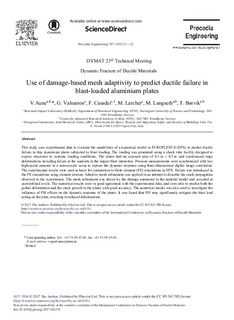| dc.contributor.author | Aune, Vegard | |
| dc.contributor.author | Valsamos, Georgios | |
| dc.contributor.author | Casadei, Folco | |
| dc.contributor.author | Larcher, Martin | |
| dc.contributor.author | Langseth, Magnus | |
| dc.contributor.author | Børvik, Tore | |
| dc.date.accessioned | 2017-11-09T10:14:06Z | |
| dc.date.available | 2017-11-09T10:14:06Z | |
| dc.date.created | 2017-09-15T09:24:39Z | |
| dc.date.issued | 2017 | |
| dc.identifier.citation | Procedia Engineering. 2017, 197 3-12. | nb_NO |
| dc.identifier.issn | 1877-7058 | |
| dc.identifier.uri | http://hdl.handle.net/11250/2465165 | |
| dc.description.abstract | This study uses experimental data to evaluate the capabilities of a numerical model in EUROPLEXUS (EPX) to predict ductile failure in thin aluminium plates subjected to blast loading. The loading was generated using a shock tube facility designed to expose structures to extreme loading conditions. The plates had an exposed area of 0.3 m × 0.3 m and experienced large deformations including failure at the supports at the largest blast intensities. Pressure measurements were synchronized with two high-speed cameras in a stereoscopic setup to capture the dynamic response using three-dimensional digital image correlation. The experimental results were used as basis for comparison to finite element (FE) simulations in EPX. Failure was introduced in the FE simulations using element erosion. Adaptive mesh refinement was applied in an attempt to describe the crack propagation observed in the experiments. The mesh refinement was driven by the damage parameter in the material model and occurred at user-defined levels. The numerical results were in good agreement with the experimental data, and were able to predict both the global deformation and the crack growth in the plates with good accuracy. The numerical model was also used to investigate the influence of FSI effects on the dynamic response of the plates. It was found that FSI may significantly mitigate the blast load acting on the plate, resulting in reduced deformations. | nb_NO |
| dc.language.iso | eng | nb_NO |
| dc.publisher | Elsevier | nb_NO |
| dc.rights | Attribution-NonCommercial-NoDerivatives 4.0 Internasjonal | * |
| dc.rights.uri | http://creativecommons.org/licenses/by-nc-nd/4.0/deed.no | * |
| dc.title | Use of damage-based mesh adaptivity to predict ductile failure in blast-loaded aluminium plates | nb_NO |
| dc.type | Journal article | nb_NO |
| dc.type | Peer reviewed | nb_NO |
| dc.description.version | publishedVersion | nb_NO |
| dc.source.pagenumber | 3-12 | nb_NO |
| dc.source.volume | 197 | nb_NO |
| dc.source.journal | Procedia Engineering | nb_NO |
| dc.identifier.doi | 10.1016/j.proeng.2017.08.076 | |
| dc.identifier.cristin | 1493990 | |
| dc.description.localcode | © 2017 The Authors. Published by Elsevier Ltd. This is an open access article under the CC-BY-NC-ND 4.0 license (http://creativecommons.org/licenses/by-nc-nd/4.0/) | nb_NO |
| cristin.unitcode | 194,64,45,0 | |
| cristin.unitname | Institutt for konstruksjonsteknikk | |
| cristin.ispublished | true | |
| cristin.fulltext | original | |
| cristin.qualitycode | 1 | |

